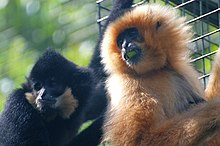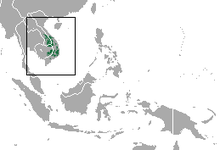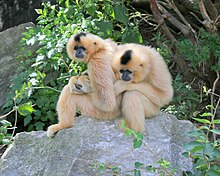
Gibbons are apes in the family Hylobatidae. The family historically contained one genus, but now is split into four extant genera and 20 species. Gibbons live in subtropical and tropical rainforests from eastern Bangladesh to Northeast India to southern China and Indonesia.

Cát Tiên National Park is a national park located in the south of Vietnam, in the provinces of Đồng Nai, Bình Phước and Lâm Đồng. It is approximately 150 km north of Ho Chi Minh City. It has an area of about 720 km2 and protects one of the largest areas of lowland tropical forests left in Vietnam. Since 2011, Cát Tiên National Park has been a part of Đồng Nai Biosphere Reserve.

Nomascus is the second-most speciose genus of the gibbon family, Hylobatidae. Originally, this genus was a subgenus of Hylobates, with all individuals considered to be one species, H. concolor.

The stump-tailed macaque, also called the bear macaque, is a species of macaque native to South Asia and Southeast Asia. In India, it occurs south of the Brahmaputra River, in the northeastern part of the country. Its range in India extends from Assam and Meghalaya to eastern Arunachal Pradesh, Nagaland, Manipur, Mizoram and Tripura.
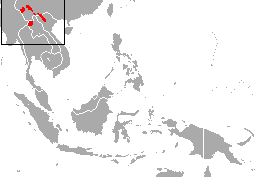
The black crested gibbon is a Critically Endangered species of gibbon found in China, Laos, and northern Vietnam, with four subspecies.
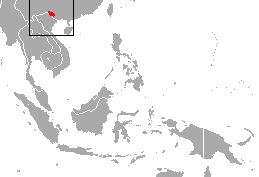
The eastern black-crested gibbon, also known as the Cao-vit black crested gibbon or the Cao-vit crested gibbon, is a species of gibbon from southeast China and northern Vietnam. The term "Cao-vit" originated from the sounds of their calls or songs that villagers of Ngoc Khe, Phong Nam and Ngoc Con communes of Trung Khanh District, Cao Bang Province of Vietnam use to name for them. This name was officially used by gibbon experts since the rediscovery.

The black-shanked douc is an endangered species of douc found mostly in the forests of Eastern Cambodia, with some smaller populations in Southern Vietnam. The region they are mostly found in is called the Annamite Range, a mountainous area that passes through Cambodia and Vietnam. Its habitat is mostly characterized by evergreen forest in the mountains, in the middle to upper canopy. They move around quadrupedally and by brachiation up in the trees. This species is unique with its coloration among the doucs as it has a bluish face with yellow rings around its eyes a blue scrotum and a pink penis. Like other doucs, this specie has a tail as long as its body and head length. Black-shanked douc have been observed in groups ranging from 3 to 30 individuals, depending on their habitat. Group tend to have a fission-fusion dynamic that changes with food availability. Their diet varies from dry to wet season. Regardless of the season, their diet consists mostly of leaves, but they have also been found to consume considerable amounts of fruits and flowers during wet season. The species changed conservation status in 2015 from endangered to critically endangered in the IUCN Red List of Endangered Species. This reassessment is due to an increase of the rate of population decline. No global population estimate exists. The majority of the population can be found in Cambodia, with smaller populations in Vietnam. In fact, the Wildlife Conservation Society reports almost 25,000 individuals in Cambodia's Keo Seima Wildlife Sanctuary, a population that has remained stable over the last decade. The largest populations estimated to be in Vietnam is around 500-600 individuals. The biggest challenges that the black-shanked douc faces in terms of conservation are habitat loss and illegal poaching. Conservation efforts are being made to control illegal poaching and trade in Vietnam by putting laws against hunting and trading threatened species.
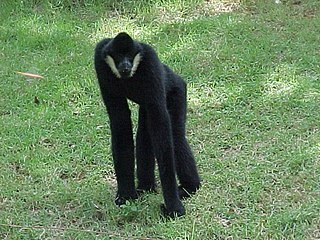
The northern white-cheeked gibbon is a Critically Endangered species of gibbon native to South East Asia.

The wildlife of Cambodia is very diverse with at least 162 mammal species, 600 bird species, 176 reptile species, 900 freshwater fish species, 670 invertebrate species, and more than 3000 plant species. A single protected area, Keo Seima Wildlife Sanctuary, is known to support more than 950 total species, including 75 species that are listed as globally threatened on the IUCN Red List. An unknown amount of species remains to be described by science, especially the insect group of butterflies and moths, collectively known as lepidopterans.
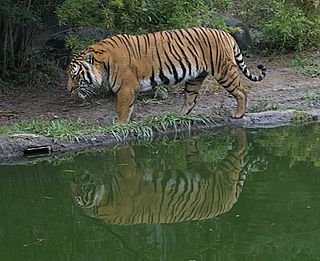
The wildlife of Laos encompasses the animals and plants found in the Lao People's Democratic Republic, a landlocked country in southeastern Asia. Part of the country is mountainous and much of it is still clad in tropical broadleaf forest. It has a great variety of animal and plant species.

Germain's langur is an Old World monkey native to Thailand, Myanmar, Cambodia, Laos and Vietnam. The monkey was previously included in Trachypithecus cristatus and Trachypithecus villosus.

The Hainan black-crested gibbon or Hainan gibbon, is a Critically Endangered species of gibbon found only on Hainan Island, China. It was formerly considered a subspecies of the eastern black crested gibbon from Hòa Bình and Cao Bằng provinces of Vietnam and Jingxi County in Guangxi Zhuang Autonomous Region, China. Molecular data, together with morphology and call differences, suggest it is a separate species. Its habitat consists of broad-leaved forests and semi-deciduous monsoon forests. It feeds on ripe, sugar-rich fruit, such as figs and, at times, leaves, and insects.

The southern white-cheeked gibbon is a species of gibbon native to Vietnam and Laos. It is closely related to the northern white-cheeked gibbon and the yellow-cheeked gibbon ; it has previously been identified as a subspecies of each of these.

The World's 25 Most Endangered Primates is a list of highly endangered primate species selected and published by the International Union for Conservation of Nature (IUCN) Species Survival Commission (SSC) Primate Specialist Group (PSG), the International Primatological Society (IPS), Global Wildlife Conservation (GWC), and Bristol Zoological Society (BZS). The IUCN/SSC PSG worked with Conservation International (CI) to start the list in 2000, but in 2002, during the 19th Congress of the International Primatological Society, primatologists reviewed and debated the list, resulting in the 2002–2004 revision and the endorsement of the IPS. The publication was a joint project between the three conservation organizations until the 2012–2014 list when BZS was added as a publisher. The 2018–2020 list was the first time Conservation International was not among the publishers, replaced instead by GWC. The list has been revised every two years following the biannual Congress of the IPS. Starting with the 2004–2006 report, the title changed to "Primates in Peril: The World's 25 Most Endangered Primates". That same year, the list began to provide information about each species, including their conservation status and the threats they face in the wild. The species text is written in collaboration with experts from the field, with 60 people contributing to the 2006–2008 report and 85 people contributing to the 2008–2010 report. The 2004–2006 and 2006–2008 reports were published in the IUCN/SSC PSG journal Primate Conservation,, since then they have been published as independent publications.

The northern buffed-cheeked gibbon is a newly discovered species of crested gibbon which is found in Vietnam, Cambodia, and Laos. Its habitat is in the humid subtropical and seasonal tropical forests of these countries.
Stephen David Nash is an English wildlife artist who primarily specialises on primates. He is currently based at the Stony Brook University on Long Island, New York, USA, in the Department of Anatomical Sciences where he works as a visiting research associate.
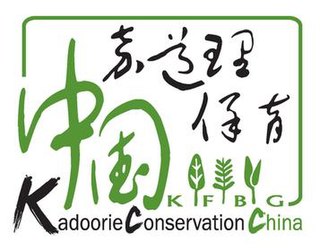
Kadoorie Conservation China (KCC) is a department under Kadoorie Farm and Botanic Garden, which aims to minimize the loss of biodiversity and promote sustainability in China.
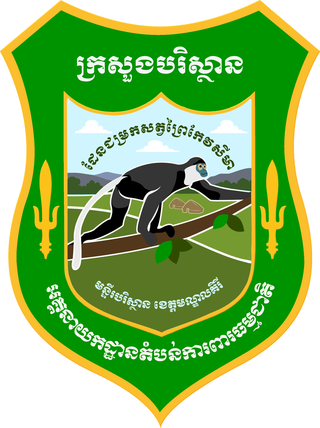
Keo Seima Wildlife Sanctuary is a 2,926.9 km2 (1,130.1 sq mi) protected area of mixed seasonal tropical forest in eastern Cambodia, located in Mondulkiri and Kratié provinces. The area was first established as Seima Biodiversity Conservation Area in 2002, later becoming Seima Protection Forest in 2009, finally becoming Keo Seima Wildlife Sanctuary in 2016. The site is of national, regional, and global importance for a range of biodiversity, with more than 950 species recorded within the protected area. It is also the ancestral and contemporary home of a large number of the Bunong ethnic group.
Gabrielle Maud Vassal was a British-born naturalist.
